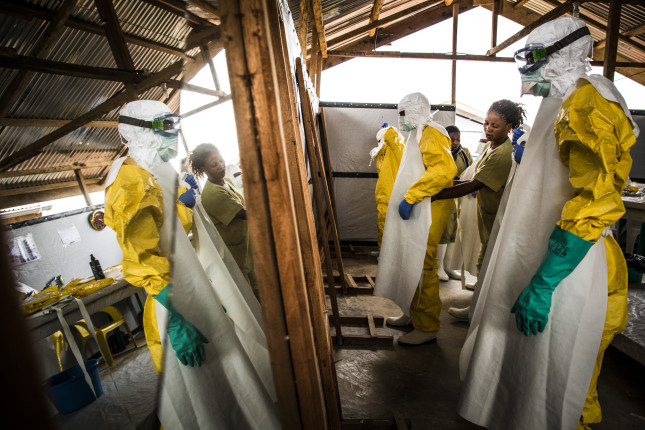-
Preventing the Next Pandemic: Scaling Laboratory Operations in Developing Countries
July 8, 2022 By Emily Nink
In 1976, a Belgian Catholic mission and hospital in what is now the Democratic Republic of the Congo (DRC) was stricken with a mysterious illness that caused fever-like symptoms. Most of the patients who contracted the illness died. A young microbiologist named Jean-Jacques Muyembe Tamfum was called to the mission, where he extracted blood samples from those who had fallen ill. The DRC did not have a functional research laboratory at the time, so Muyembe had to send his samples to Belgium for analysis. The results that came back revealed that they contained a new deadly virus: what the world came to know as Ebola, named after a river near the mission.
The virus that was novel almost fifty years ago is now recurrent—and intensifying in its occurrences. Today, the DRC is facing its sixth Ebola outbreak in the last four years. While risk of transmission remains high (due to “spillover” that occurs when the virus jumps from animals to humans), the labors of Professor Muyembe have ensured that the country is now better equipped to contain the spread of not only Ebola, but also other emerging infectious diseases.
At a recent symposium hosted by the George Washington University Milken Institute School of Public Health and the Mérieux Foundation USA, Muyembe shared the story of his life’s work. It is a journey that not only led to his discovery of an antiviral Ebola treatment, but also a quest to equip the National Institute of Biomedical Research (INRB) that he directs in the DRC.
“For more than four decades since its discovery in 1976, [Ebola had] no treatment or vaccine,” said Professor Muyembe in his keynote address. “Today, thanks to international collaboration, Ebola virus disease is preventable and curable.”
Investing in Laboratory Capacity
In her remarks at the symposium, Dr. Rebecca Katz, director of Georgetown’s Center for Global Health Science and Security, observed that international collaboration is more than just one-off funding for laboratory equipment and staff. It takes a strong partnership to find the “right balance between what the needs are, as defined by the country, and then being able to match that to both national-level investments as well as global investments.”
That’s where the Infectious Disease Detection and Surveillance (IDDS) project, funded by the U.S. Agency for International Development (USAID), comes in. The project’s impact goes far beyond Ebola and the DRC, aiming to strengthen countries’ laboratories and health systems to quickly detect, track, and respond to infectious disease threats. The project has already supported more than 100 laboratories to improve testing and trained 2,000 people on disease surveillance. On a broader front, the IDDS project also has spearheaded 31 national strategies and plans to accomplish this work.
Muyembe’s nation has remained on the front lines of these larger efforts. During the Ebola outbreak of 2018–2020, USAID and the Mérieux Foundation funded and supported the Rodolphe Mérieux Laboratory at INRB Goma to address lack of testing and surveillance capacity in the eastern territory of the DRC. When COVID-19 arrived, the lab became the main testing center in eastern DRC and the base for outbreak control in that region.
“The response to the new emerging infections all depends on labs being able to get the diagnosis right and then being able to scale up diagnostic testing efforts in the community,” explained Dr. Tom Inglesby, director of the Center for Health Security at the Johns Hopkins Bloomberg School of Public Health, to the audience at the Milken symposium. “We need to identify cases quickly, which means not only diagnosing those who are initially present, but also going out and doing active surveillance in the community to quickly seek out new cases. We need diagnostic tests that are widely available, not only in reference labs.”
Seeking Skilled Collaborators
In the DRC and nearly two dozen other countries, IDDS is working to decentralize laboratory services and make these tests more widely available. One of the major challenges is retaining skilled laboratory workers.
Significant investments are required to sustain the efforts to train health workers, ensure compliance with national and international guidelines, and accredit programs and laboratories. But when these initiatives are led by local experts and supported by international aid, they work.
“From 1998 to 2003, I was the only PhD at the INRB,” noted Muyembe. “Today, I am surrounded by a team of PhD collaborators. Most of these PhDs were trained abroad, but they all decided to come back and work at the INRB because we have developed research infrastructure at the INRB.”
Further substantial investments will be needed to replicate Muyembe’s success in the DRC and stop infectious diseases at their source. “There’s never been sufficient funding,” said Dr. Katz. “There is not currently sufficient funding—and we need a lot more money to be able to build sufficient capacity to be able to prevent, detect, and respond to public health emergencies.”
Emily Nink is a senior health technical writer at ICF. The views expressed here are the author’s and do not necessarily represent those of USAID or the Mérieux Foundation.
Sources: World Health Organization; Mérieux Foundation; USAID
Photo Credit: In Beni, North Kivu region, Democratic Republic of Congo, health workers put their Personal Protective Equipment on before entering the zone where people suspected of having Ebola are held in quarantine to be monitored and treated, courtesy of Flickr user World Bank Photo Collection/Vincent Tremeau
 A Publication of the Stimson Center.
A Publication of the Stimson Center.






